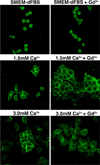Growth control in colon epithelial cells: gadolinium enhances calcium-mediated growth regulation
- PMID: 23008064
- PMCID: PMC3661021
- DOI: 10.1007/s12011-012-9503-9
Growth control in colon epithelial cells: gadolinium enhances calcium-mediated growth regulation
Abstract
Gadolinium, a member of the lanthanoid family of transition metals, interacts with calcium-binding sites on proteins and other biological molecules. The overall goal of the present investigation was to determine if gadolinium could enhance calcium-induced epithelial cell growth inhibition in the colon. Gadolinium at concentrations as low as 1-5 μM combined with calcium inhibits proliferation of human colonic epithelial cells more effectively than calcium alone. Gadolinium had no detectable effect on calcium-induced differentiation in the same cells based on change in cell morphology, induction of E-cadherin synthesis, and translocation of E-cadherin from the cytosol to the cell surface. When the colon epithelial cells were treated with gadolinium and then exposed to increased calcium concentrations, movement of extracellular calcium into the cell was suppressed. In contrast, gadolinium treatment had no effect on ionomycin-induced release of stored intracellular calcium into the cytoplasm. Whether these in vitro observations can be translated into an approach for reducing abnormal proliferation in the colonic mucosa (including polyp formation) is not known. These results do, however, provide an explanation for our recent findings that a multi-mineral supplement containing all of the naturally occurring lanthanoid metals including gadolinium are more effective than calcium alone in preventing colon polyp formation in mice on a high-fat diet.
Figures





Similar articles
-
Calcium-Induced Differentiation of Human Colon Adenomas in Colonoid Culture: Calcium Alone versus Calcium with Additional Trace Elements.Cancer Prev Res (Phila). 2018 Jul;11(7):413-428. doi: 10.1158/1940-6207.CAPR-17-0308. Epub 2018 Apr 10. Cancer Prev Res (Phila). 2018. PMID: 29636350 Free PMC article.
-
Calcium, calcium-sensing receptor and growth control in the colonic mucosa.Histol Histopathol. 2011 Jun;26(6):769-79. doi: 10.14670/HH-26.769. Histol Histopathol. 2011. PMID: 21472691 Free PMC article. Review.
-
Induction of calcium sensing receptor in human colon cancer cells by calcium, vitamin D and aquamin: Promotion of a more differentiated, less malignant and indolent phenotype.Mol Carcinog. 2015 Jul;54(7):543-53. doi: 10.1002/mc.22123. Epub 2013 Dec 17. Mol Carcinog. 2015. PMID: 26076051
-
Human colon tissue in organ culture: calcium and multi-mineral-induced mucosal differentiation.In Vitro Cell Dev Biol Anim. 2011 Jan;47(1):32-8. doi: 10.1007/s11626-010-9358-3. Epub 2010 Nov 20. In Vitro Cell Dev Biol Anim. 2011. PMID: 21104039 Free PMC article.
-
Strategies for colon cancer prevention.Ann N Y Acad Sci. 1995 Sep 30;768:170-9. doi: 10.1111/j.1749-6632.1995.tb12120.x. Ann N Y Acad Sci. 1995. PMID: 8526346 Review. No abstract available.
Cited by
-
A Multi-Mineral Intervention to Modulate Colonic Mucosal Protein Profile: Results from a 90-Day Trial in Human Subjects.Nutrients. 2021 Mar 14;13(3):939. doi: 10.3390/nu13030939. Nutrients. 2021. PMID: 33799486 Free PMC article. Clinical Trial.
-
Liver Protein Expression in NASH Mice on a High-Fat Diet: Response to Multi-Mineral Intervention.Front Nutr. 2022 May 11;9:859292. doi: 10.3389/fnut.2022.859292. eCollection 2022. Front Nutr. 2022. PMID: 35634402 Free PMC article.
-
Proteins and Carbohydrates from Red Seaweeds: Evidence for Beneficial Effects on Gut Function and Microbiota.Mar Drugs. 2015 Aug 20;13(8):5358-83. doi: 10.3390/md13085358. Mar Drugs. 2015. PMID: 26308006 Free PMC article. Review.
-
Ulcerative Dermatitis in C57BL/6NCrl Mice on a Low-Fat or High-Fat Diet With or Without a Mineralized Red-Algae Supplement.J Am Assoc Lab Anim Sci. 2015 Sep;54(5):487-96. J Am Assoc Lab Anim Sci. 2015. PMID: 26424246 Free PMC article.
-
Differentiation of human colon tissue in culture: Effects of calcium on trans-epithelial electrical resistance and tissue cohesive properties.PLoS One. 2020 Mar 5;15(3):e0222058. doi: 10.1371/journal.pone.0222058. eCollection 2020. PLoS One. 2020. PMID: 32134920 Free PMC article.
References
-
- Bostick RM, Potter JD, Sellers TA, McKenzie DR, Kushi LH, Folsom AR. Calcium, vitamin D, dairy foods intake to incidence of colon cancer among older women. The Iowa women’s health study. Am J Epidemiol. 1993;137:1302–1317. - PubMed
-
- Kampman E, Giovannucci E, van ‘t Veer P, Rimm E, Stampfer MJ, Colditz GA, Kok FJ, Willett WC. Calcium, vitamin D, dairy foods, and the occurrence of colorectal adenomas among men and women in two prospective studies. Am J Epidemiol. 1994;139:16–29. - PubMed
-
- Kampman E, Slattery ML, Caan B, Potter JD. Calcium, vitamin D, sunshine exposure, dairy products and colon cancer risk (United States) Cancer Causes Control. 2000;11:459–466. - PubMed
-
- McCullough ML, Robertson AS, Rodriguez C, Jacobs EJ, Chao A, Carolyn J, Calle EE, Willett WC, Thun MJ. Calcium, vitamin D, dairy products, and risk of colorectal cancer in the Cancer Prevention Study II Nutrition Cohort (United States) Cancer Causes Control. 2003;14:1–12. - PubMed
-
- Flood A, Peters U, Chatterjee N, Lacey JV, Jr, Schairer C, Schatzkin A. Calcium from diet and supplements is associated with reduced risk of colorectal cancer in a prospective cohort of women. Cancer Epidemiol Biomarkers Prev. 2005;14:126–132. - PubMed
Publication types
MeSH terms
Substances
Grants and funding
LinkOut - more resources
Full Text Sources
Medical

